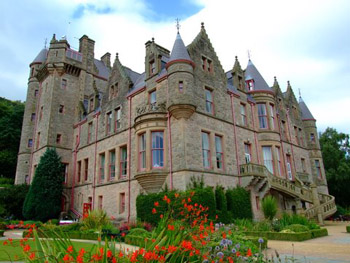Historic Belfast, Northern Ireland
by John Rooney
When the first rays of sunlight break through the cold early morning mist, to reveal the uppermost peaks of Belfast’s Cave Hill, it’s easy for me to see why it’s said to have inspired Jonathan Swift to write his most well known novel, Gulliver’s Travels.
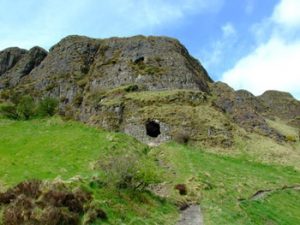 Silhouetted against the palest blue sky, the craggy basalt summit forms the outline of a man staring upwards and into heavens. Known locally as ‘Napoleon’s Nose’ it not only bears an uncanny resemblance to the famous emperor, but is also reminiscent of the sleeping giant in the classic tale.
Silhouetted against the palest blue sky, the craggy basalt summit forms the outline of a man staring upwards and into heavens. Known locally as ‘Napoleon’s Nose’ it not only bears an uncanny resemblance to the famous emperor, but is also reminiscent of the sleeping giant in the classic tale.
Rising to over 1200 feet above sea level, the Cave Hill is Belfast’s most prominent feature and despite being only a few miles from the city centre it is perhaps one of Northern Ireland’s best kept secrets. Originally known in Gaelic as Beann Mheadagáin (the Hill of Madigan), named after an ancient king, the hill now takes its name from a number of caves which are thought to be early iron mines, dug into its steep rock face.
As well as providing the perfect hunting ground for peregrines, kestrels and ravens, the hill is home to Belfast Castle, Zoological gardens and some of the finest woodland trails to be found anywhere. The summit provides panoramic views of Belfast Lough and is also the site of several primordial raths (forts), dating back to between 400 – 1200 AD.
In Victorian times Limestone was mined on the hill’s southern flanks, then transported to Belfast Docks by a horse-drawn railway system and two hamlets, ‘Mammystown and Daddystown,’ were built on either side of the track to accommodate quarry workers. The railway was abandoned in the 1890s and the two villages are nothing more than references on survey maps of the time. But many streets and avenues close to the hill bear the name ‘Waterloo,’ in reference to their geological origins.
During the Second World War Belfast’s shipbuilding industry was heavily bombed by the German Luftwaffe and on one such raid a bomb was dropped on the Cave Hill, causing a huge crater close to Belfast Castle. And sadly on 1st June 1944, while flying through thick fog, an American B-17 bomber crashed into the Cave Hill, killing all ten crew members instantly. The site of the unfortunate incident is marked with a plaque in the grounds of the Zoological Gardens.
Being a native of Belfast I’ve walked these hills many times and usually approach via the Hightown Road entrance. There’s a small car-park marked with two stone pillars. On my left is thick woodland which occasionally gives way to reveal the underlying basalt, while on my right the hillside descends into a vista of vibrant green valleys and dense vegetation.
The hardcore path makes my ascent relatively straightforward (if somewhat breathless due to the sometimes steep incline), and it isn’t long before I’m making my way through a patchwork of yellowish-brown heathers and bog cotton. Meadow Pipits and Skylarks provide a pleasant chorus over the open moor-land and there’s a strong westerly breeze that swirls around my legs, threatening to throw me of the rugged cliffs should I venture too close to the edge.
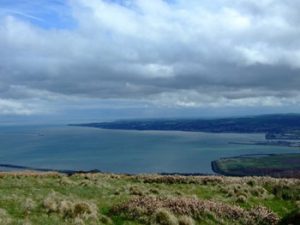 Below me, Belfast Lough reflects the bluish-grey tones of the sky, as it makes its way past Carrickfergus and into the Irish Sea, where I can just make out the ashen outline of the Isle of Man.
Below me, Belfast Lough reflects the bluish-grey tones of the sky, as it makes its way past Carrickfergus and into the Irish Sea, where I can just make out the ashen outline of the Isle of Man.
Straight ahead and some five miles across the lough, the small costal towns of Bangor, Hollywood and Newcastle, nestle beneath the safety of the cornflower-blue Mourne Mountains. On my right Harland and Wolfe’s two colossal yellow cranes, mark not only the birth place of the Titanic, but are reminder that during the late 19th century Belfast was the industrial capital of Europe.
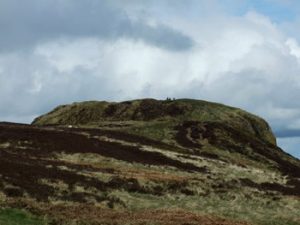 Further along the track and McArts Fort comes into view. The huge grass covered mound measuring 150 feet by 180 feet, is the remains of an ancient circular fort and balances somewhat precariously on an almost vertical slab of rock. It’s hardly surprising that the United Irishmen, Wolfe Tone and Henry Joy McCracken, chose this exact spot to plot the Irish rebellion of 1798. With its inaccessible cliffs and views of the surrounding area, it’s the perfect place to conspire treason.
Further along the track and McArts Fort comes into view. The huge grass covered mound measuring 150 feet by 180 feet, is the remains of an ancient circular fort and balances somewhat precariously on an almost vertical slab of rock. It’s hardly surprising that the United Irishmen, Wolfe Tone and Henry Joy McCracken, chose this exact spot to plot the Irish rebellion of 1798. With its inaccessible cliffs and views of the surrounding area, it’s the perfect place to conspire treason.
On passing the fort I begin my descent along the narrow track past the Devil’s Punchbowl (an area of boulders, where it’s believed ancient Celtic farmers corralled their cattle), to enter the castle estate. The air is heavy with the pungent aroma of wild Garlic and the overhead trees grant me respite from the mid-day sun. The trees provide the perfect habitat for a variety of woodland birds and if I’m lucky I might catch a fleeting glimpse of a grey squirrel, or towards dusk a hedgehog or badger.
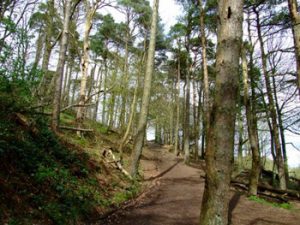 After crossing a narrow stream, no wider than an average persons step, I make my way along the tree lined avenue that leads to Belfast Castle. The castle is a large sandstone building, built in the Scottish Baronial style and was designed by John Lanyon in 1867, as home to the 3rd Marquis of Donegall. Construction was completed in 1870 and following the Marquis’ death in 1884, it became home to Shaftesbury’s.
After crossing a narrow stream, no wider than an average persons step, I make my way along the tree lined avenue that leads to Belfast Castle. The castle is a large sandstone building, built in the Scottish Baronial style and was designed by John Lanyon in 1867, as home to the 3rd Marquis of Donegall. Construction was completed in 1870 and following the Marquis’ death in 1884, it became home to Shaftesbury’s.
The Shaftesbury’s were well known for supporting local charities and held fetes within the castle grounds, and in 1907 the 9th Earl of Shaftesbury was appointed Lord Mayor of Belfast. The castle bears witness to both families; the Donegall coat of arms can be seen above the front door and on the building’s north wall, whilst a section of the Shaftesbury crest appears on the exterior Italian style, serpentine staircase.
Belfast City Council took control in 1934, when the family presented the castle and surrounding estate to the city. Then following a major refurbishment program instigated by the council in 1978 and costing £2 million, the castle is now a popular venue for wedding receptions and conferences.
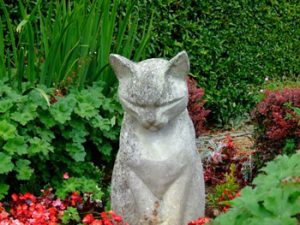 Adjacent to the castle is the ‘cat garden.’ Legend has it that the castle has always had a resident white cat and that those visiting the castle will have good luck, provided the tradition is maintained. It’s thought that the custom began when a sociable feline befriended the castle’s gardeners and as I make my way down the stone steps leading to the garden, I feel certain that some good fortune will come my way.
Adjacent to the castle is the ‘cat garden.’ Legend has it that the castle has always had a resident white cat and that those visiting the castle will have good luck, provided the tradition is maintained. It’s thought that the custom began when a sociable feline befriended the castle’s gardeners and as I make my way down the stone steps leading to the garden, I feel certain that some good fortune will come my way.
The garden’s centre piece is a small decorative fountain where a bronze feline slumbers in the summer sun. On either side of the water feature set in red brick paving, two mosaic felines welcome me to their home, whilst below me a feline carefully sculpted from the semi-evergreen ‘Privet’ soaks up the tranquil atmosphere. There are nine cats for nine lives depicted in the garden’s furniture and paving. My favorite is a statuesque mouser who sits elegantly in a bed of Roseglow (above).
The castle has a bar, restaurant and an antique shop. But before I enter for some much needed refreshment, I’ll take a seat on one of the wooden benches and just like those who first inhabited the hill over 1200 years ago, I’ll watch the sun setting over Belfast Lough.
If You Go:
The Cave Hill is susceptible to extreme weather conditions, whilst some of its cliffs are hazardous and are not suitable for amateurs. Sturdy footwear and waterproof clothing is advisable. For full details on how to get there and to download a PDF map of the advised route please visit:
www.belfastcity.gov.uk To learn about Jonathan Swift and Gulliver’s Travels: www.incompetech.com
Belfast Tours Now Available:
Belfast History Walking Tour The Ultimate Belfast experience
Belfast Mural Political Black Cab Tour
Titanic Walking Tour in Belfast
Guided Tour of Crumlin Road Gaol in Belfast
About the author:
John Rooney is a freelance writer and photographer working and living in County Antrim, Northern Ireland. His work has appeared in a variety of magazines and features regularly in ‘Ireland’s Own’. John’s website is www.freewebs.com/johnrooney1 His blog is at http://jon1words.blogspot.com Email: wordwelder58@yahoo.com
All photos are by John Rooney.
